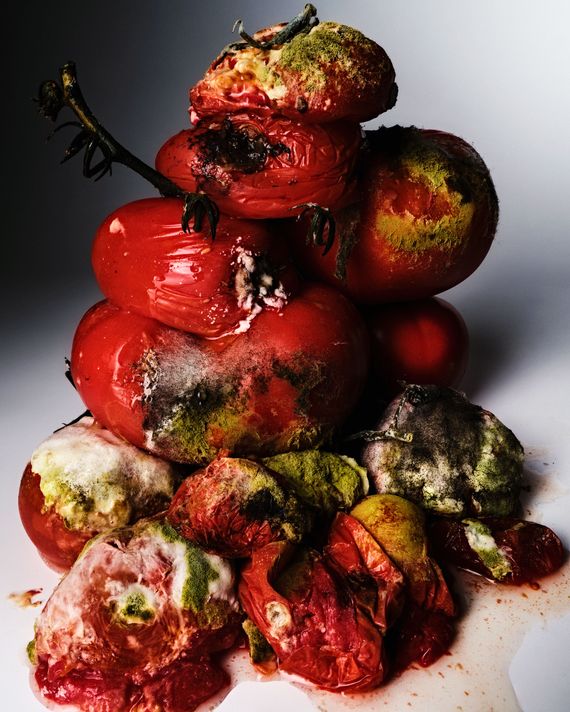In 2021, Duval Clemmons, a retiree from the West Bronx, went to his local BJ’s Wholesale Club and discovered a pleasant surprise in the dairy aisle. Clemmons, sixty-eight, had a long career as a maintenance worker, but was disabled when he fell down some subway stairs, in 2009. “I’m trying to eat healthy when I can, and when I can afford it,” he told me recently. “So when I seen plant-based butter, I said, ‘Oh, this is real cool. This is what I need.’ ” What he saw was Country Crock Plant Butter Made with Olive Oil, a product with a green lid and a label showing a leafy olive branch floating above a buttered slice of toast, with the words “New!” and “Dairy Free” in delighted-looking cursive. “Most margarines, they don’t put pictures of the ingredients,” Clemmons went on.
Clemmons, like many of us, had veered toward margarine in the late twentieth century, believing it to be a healthier alternative to butter. “Margarine was my go-to thing,” he told me. “Margarine was amazing. But when I found out that it’s also an artery clogger, in the early two-thousands, I switched over to olive oil.” Clemmons knows many people with heart disease; some of his friends have died from it. He bought the Country Crock and began to eat it on his toast. A few months later, he saw an image of the product online, in an ad looking for members of a class-action lawsuit. Reading, he made a startling discovery: the spread wasn’t made of olive oil, or even mostly made of olive oil. The primary ingredient was a processed blend of palm and canola oils. “I’d been drawn in because of the picture,” Clemmons told me. “And they knew that. I’m sure they knew that. Why wouldn’t people be attracted to things that are natural?”
Read the rest of this article at: The New Yorker
In 2018, a movie-publicity company called Bunker 15 took on a new project: Ophelia, a feminist retelling of Hamlet starring Daisy Ridley. Critics who had seen early screenings had published 13 reviews, seven of them negative, which translated to a score of 46 percent on the all-important aggregation site Rotten Tomatoes — a disappointing outcome for a film with prestige aspirations and no domestic distributor.
But just because the “Tomatometer” says a title is “rotten” — scoring below 60 percent — it doesn’t need to stay that way. Bunker 15 went to work. While most film-PR companies aim to get the attention of critics from top publications, Bunker 15 takes a more bottom-up approach, recruiting obscure, often self-published critics who are nevertheless part of the pool tracked by Rotten Tomatoes. In another break from standard practice, several critics say, Bunker 15 pays them $50 or more for each review. (These payments are not typically disclosed, and Rotten Tomatoes says it prohibits “reviewing based on a financial incentive.”)
In October of that year, an employee of the company emailed a prospective reviewer about Ophelia: “It’s a Sundance film and the feeling is that it’s been treated a bit harshly by some critics (I’m sure sky-high expectations were the culprit) so the teams involved feel like it would benefit from more input from different critics.”
“More input from different critics” is not very subtle code, and the prospective critic wrote back to ask what would happen if he hated the film. The Bunker 15 employee replied that of course journalists are free to write whatever they like but that “super nice ones (and there are more critics like this than I expected)” often agreed not to publish bad reviews on their usual websites but to instead quarantine them on “a smaller blog that RT never sees. I think it’s a very cool thing to do.” If done right, the trick would help ensure that Rotten Tomatoes logged positive reviews but not negative ones.
Between October 2018 and January 2019, Rotten Tomatoes added eight reviews to Ophelia’s score. Seven were favorable, and most came from critics who have reviewed at least one other Bunker 15 movie. The writer of a negative review says that Bunker 15 lobbied them to change it; if the critic wanted to “give it a (barely) overall positive then I do know the editors at Rotten Tomatoes and can get it switched,” a Bunker 15 employee wrote. I also discovered another negative review of Ophelia from this period that was not counted by Rotten Tomatoes, by a writer whose positive reviews of other Bunker 15 films have been recorded by the aggregator. Ophelia climbed the Tomatometer to 62 percent, flipping from rotten to “fresh.” The next month, the distributor IFC Films announced that it had acquired Ophelia for release in the U.S.
Read the rest of this article at: Vulture
:format(webp)/cdn.vox-cdn.com/uploads/chorus_image/image/72632019/PryorCocoGauff_AP_Ringer.0.jpg)
In section 131 at Arthur Ashe Stadium, we were waiting for the moment to arrive right up until it did. Patience is sometimes the price of greatness, and it’s rarely a price that’s too steep. In Saturday’s U.S. Open final, the 19-year-old prodigy Coco Gauff faced down fate, failure, and fury and returned neither broken nor untouched. That’s pretty much the Holy Grail of sports drama, if ever there was one.
Gauff lagged out of the gate against second-ranked Aryna Sabalenka, fumbled the opening set, and nearly dug her own tomb. Then, like any decent miracle maker, she pulled herself out. A string of spitball returns from the outer reaches of the baseline earned Gauff a break. A ground game tighter than concrete helped her keep it. At an hour and 24 minutes, she evened the score at one set apiece. Less than 45 minutes later, she had both hands gripped around the champions trophy.
In the better part of a fortnight, Gauff circled her first Grand Slam victory, sized it up, and claimed it. Across seven matches she dismantled one opponent after another, wielding a multi-blade of iron-clad defense, smoldering serves, and an untouchably cool temperament. When Saturday’s match ended, applause flowed down the densely packed slopes of the stadium, and tears flooded Gauff’s eyes. She ran into the crowd and fell into her parents’ arms. Four years after breaking onto the scene by upsetting her idol Venus Williams, the teen opened the door to the rest of her career.
Read the rest of this article at: The Ringer
In the darkness, they rose. More than 150 men and women advanced warily through the ice, grasping lines that had been anchored into the mountainside just hours before.
Some had waited months for this ascent. They had a small window: Winds had finally calmed on the morning of July 26, giving teams their first chance to summit K2, the King of Mountains, in the Pakistani-administered area of the Kashmir.
A storm would hit the mountain on the 28th, they were told. It was now, or next year.
In the vanguard was the rope-fixing team, a handpicked squad of the strongest Sherpas and guides. Working through the thick snow, they opened a route by securing ropes along the rocky Abruzzi Spur, the most common path to the peak.
Behind them, a column of headlamps peppered the Pakistani mountainside like fireflies in the fog. Up and up they went — eager athletes, Nepali Sherpas, Western mountain guides, and their foreign clients.
Near the front of the pack was the Norwegian climber Kristin Harila. By sunrise, she and her guide, Tenjen “Lama” Sherpa, would become the fastest people to reach the world’s 14 tallest peaks.
Then there was Mohammad Hassan. A Pakistani porter tasked with carrying equipment for the rope-fixing team, the 27-year-old climbed the frigid heights while positioned somewhere between the veteran climbers and Harila.
They would find him upside down that night, dangling at 27,000 feet, hanging above an abyss, his face buried in the snow.
Read the rest of this article at: Insider
An egg yolk is precious; a hundred are terrifying. In an Instagram reel from last year, a pair of disembodied hands tips a large metal bowl full of neon-orange yolks into a well of flour, an act whose ostensible purpose is to make fresh pasta but whose effect is to freak me out. The wet yolks cluster densely as if just emancipated from a sac, the sort of potential life form that portends doom in a sci-fi movie: When all of these hatch, we’re fucked. Without this shock of near-unnatural color — which ranges from clementine to cadmium — the video would lose its effect; the yolks are so dark and so plentiful you worry they might fight back. But with the whisk of a fork, their borders disappear, and they become a thick, placid pool of goo. The video ends before they get the chance to become dough.
In recent years, these shockingly orange yolks have infiltrated America’s supermarket shelves, boasting virtue and vitamins. At your local upscale grocer you might find a robin’s-egg blue carton of “heritage free range” eggs from the Happy Egg Co., six of them blue and six of them brown. The label is a dusty cobalt, interrupted by a bright orange circle: a yolk, naked and flashing you from its cracked-open shell, no white in sight.
Last spring, my boyfriend brought a dozen of these eggs into my kitchen. They seemed harmless at first, but when he scrambled them, I found myself eating a plate of eggs closer in color to Bugs Bunny’s carrot than a simple French omelette. Later, I fried one next to my last CSA (community-supported agriculture) egg, laid in the Catskills by a pasture-raised hen. Once transferred to a bowl of rice, they looked like a clone experiment gone wrong. The CSA yolk was a deep goldenrod, fat and happy-looking. The Happy Egg yolk was such an aggressive reddish orange it looked like a pustule.
Read the rest of this article at: Eater





:format(webp)/cdn.vox-cdn.com/uploads/chorus_image/image/72552898/Eater_Egg_Fetish_Hero_Update.0.jpg)